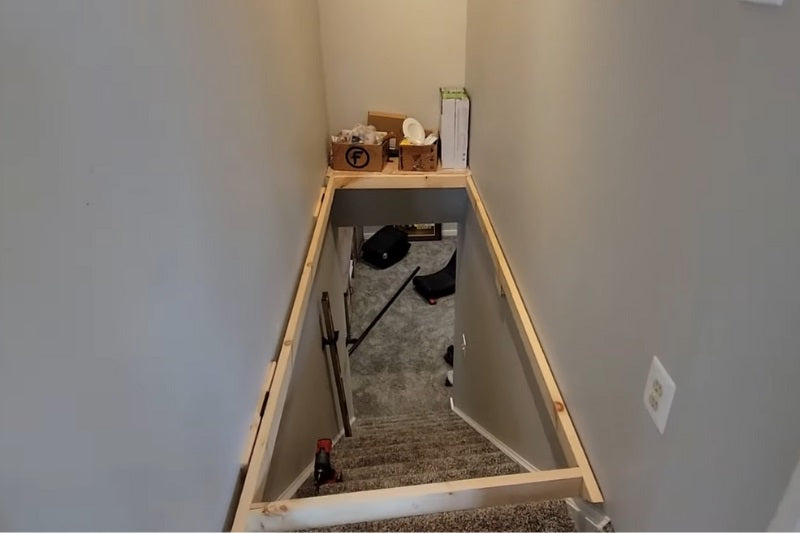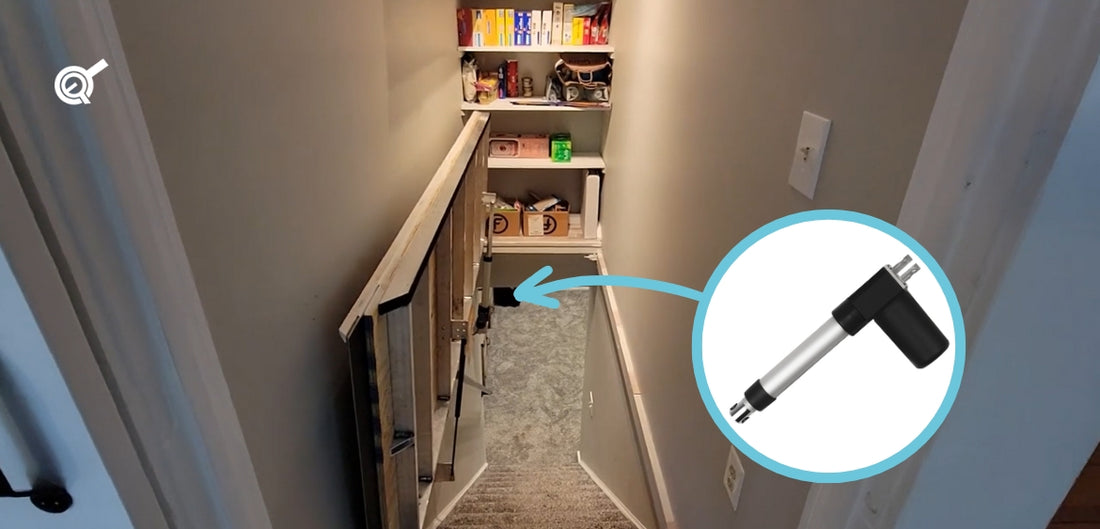Nowadays, the use of actuators in home automation can benefit homeowners in so many ways. Examples of home automation benefits include improved privacy, safety, convenience, and space optimization in confined areas. A home’s stairwell is often an area with a decent amount of unused space that can be improved through home automation for better space optimization. In this article, we will cover the highlights of how Bryan Kelly’s stairwell was converted into a pantry with a hidden door entrance to a game room!
Wooden Frame and Hinges

Before the stairwell conversion, Bryan had his belongings stored on just one level of a shelf and had to reach his hands up while standing at the bottom of the stairs for any access. A stairwell conversion would allow for greater space optimization by allowing for a hidden door that allows access to the stairs while also doubling as a floor to a pantry. Bryan used wooden framing as a temporary mock-up frame as a reference point to work with. He then placed 5-inch hinges with his cut aluminum pieces together, marked the required holes for the hinges with a pencil, and had these marks punched. To allow for his treaded screws to bite into the aluminum cut-out pieces, he then drilled the necessary pilot holes and tapped each of them.

Fabricating the Aluminum Frame and Flooring

When fabricating the aluminum frame to support the door, Bryan marked out the areas for his cross beams to ensure that they did not get in the way of the hinges that would later be added. While the hinges were screwed in place carefully, and tapped gently, 2 out of 3 of the screws were still stripped out. To resolve this issue, Bryan switched to using machine screws that would go through from one side of the frame to the other and then secured each screw at the end with a nut.
The next step was having the aluminum cross beams welded into place to result in the aluminum frame which weighs approximately 27 lbs. To complete the door which also doubles as flooring, plywood was painted and installed with the frame after drying. Bryan estimates the combined weight would be about 150 lbs after adding plywood and laminate to the aluminum frame.
Testing Out Mounting Positions with Hydraulic Assist

Hydraulic assist pistons were chosen as a way to reduce how much force would be needed to lift the door open. In the testing phase, Bryan had his Amazon mounts modified with their studs oriented so that the push and pull of the piston would be more directly translated to the mounting points. During the testing phase, Bryan required a few attempts of trial and error to eventually get the right mounting positions for the hydraulic assists to find the best balance of:
- lift force
- stroke length utilization
- door articulation (to fully open/close)
Throughout the testing phase, he also experimented with different hydraulic assist models, lengths, and pressure ratings to find the correct ones. He made custom aluminum brackets with holes drilled at equal distances between each other for added adjustability to change piston mounting positions in small increments.
Choosing An Electric Linear Actuator

The resistance of the 2x pistons themselves (each rated for 60 lbs) required some manual force to lift the door open, so Bryan decided to replace one piston with an electric actuator model PA-04-14-100 for the added convenience of automation. Besides having more than sufficient force to move the door open and close, our PA-04 actuators rated for 100 lbs of force also offered a good speed of 2.16 inches/second fully loaded. Bryan also installed mounting pins that were quick and easy to access for the front and rear mounting holes of the PA-04 actuator in case the actuator ever needed repair servicing in the future.
Wiring the Electrical System

Wireless control was made possible through the PA-31 control box that comes included with wireless remotes. One wireless remote is placed downstairs while the second remote is kept upstairs to work similarly to a three-way light switch. To ensure that the electric linear actuator shuts off in the desired position, Bryan wired the actuator to an external limit switch (AC-24 Push Button External Limit Switch). When the door presses the push button as it closes, this external limit switch shuts off electrical power for current flowing in the direction of the actuator retracting. This ensures there is no damage to the actuator or structure due to over-retracting, however, the built-in diode inside the external limit switch allows for current flow in the opposite direction when extending the door open.
The system has an electrical fuse for added safety and receives electrical power from a battery bank in his basement. This source of electrical power also works as a backup supply in case of any home power outages and has enough power to supply the house for about a day. Now that the project is complete, Bryan can benefit from the space optimization needed for a pantry while enjoying the convenience of opening and closing the hidden door entrance with the simple push of a button to gain access to the stairs and his game room.

To see Bryan’s build process of the stairwell conversion into a pantry and the hidden door entrance in action, check out the video below and visit his YouTube channel @themoneypitgarage!
IN SUMMARY
We hope you found this article as interesting as we did, especially if you were thinking of doing similar projects with a hidden door entrance or interested in space optimization around your stairwell.
Thank you, Bryan Kelly, for sharing your project! We hope your stairwell conversion into a pantry with a hidden door entrance will continue to serve you well over the years!
If you have any queries about our electric linear actuators or wish to discuss our other products further, please do not hesitate to reach out to us! We are experts in what we do and will be happy to assist in any way we can.
sales@progressiveautomations.com | 1-800-676-6123




